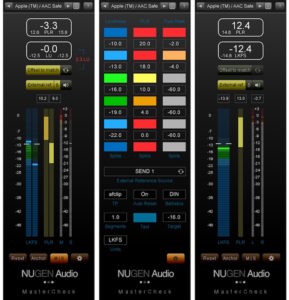- in Engineering , Production by Bobby Owsinski
- |
- 3 comments
Is Remastering Really Necessary?
 With the introduction of some very nice mastering plugins that allow you monitor your mix as it would sound on various streaming services comes the misconception that you have to submit a different master for each one, which means “remastering” your master. It’s easy to see why one might think that, but actually this is one time in life when things are actually a lot simpler than they seem. Here’s a quick overview the situation
With the introduction of some very nice mastering plugins that allow you monitor your mix as it would sound on various streaming services comes the misconception that you have to submit a different master for each one, which means “remastering” your master. It’s easy to see why one might think that, but actually this is one time in life when things are actually a lot simpler than they seem. Here’s a quick overview the situation
It’s All In The LUFS
Most streaming services have now converted over to measuring their audio levels in LUFS. LUFS is an international scale for measuring loudness that uses an algorithm that closely matches how we hear. It was instituted primarily to counter complaints about television commercials being a lot louder than the normal program, even though the meter levels read the same for both. Unlike most other metering standards that we use in audio, LUFS measures the level over time, so it provides a more accurate way to monitor the actual level of the program as we hear it (read more about LUFS here).
Streaming Levels
There are currently 2 different playback levels used by the major streaming services. Apple Music’s is -16LUFS, and YouTube, Spotify and Tidal are at -14 (the AES standard is -16). The closer to 0 LUFS you get, the louder you get, therefore Apple Music plays back a little quieter than the others.
The Misconception
With the launching of mixing and mastering plugins like Nugen Audio’s very cool Mastercheck Pro, we now have the ability to listen to what the mix will sound like after it goes through the streaming services codec and is played back. That’s where things get fuzzy. These types of plugins allow us to listen to what it will sound like, not make a separate master for it. We’re monitoring only, because there’s no need to make a new master.
No New Master Needed
Here’s what makes these plugins confusing to some. Every streaming service does it’s own encoding. Even if you supplied a new master just for the service completely encoded and at the right level, they would still encode it again! What all services request these days is at least a 44.1/16 master, and in some cases (like Tidal Premium and Apple Music) a 96/24 master.
Understand that you can’t upload your own master to any streaming service directly unless you’re at least a large indie label or an aggregator like TuneCore, CD Baby or DistroKid. What these aggregators want is a 44.1/16 master as well, because that’s what they supply to the streaming services.
That said, it’s been noted that songs that have more dynamic range sound significantly better on just about every streaming network than ones that are crushed after they get through the data compression algorithm and the level is adjusted. What that means is that even if you have the loudest sounding master on earth when played back raw or on a CD, it’s going to play back at the same level of a quiet master when streamed, and probably won’t sound as good either
So What To Do?
If you’re using a mastering engineer, he’s most likely aware of these problems and will adjust accordingly. If you’re mastering yourself, make a 44.1/16 AIF or WAV file master but leave some dynamic range (at least 9dB) in order to ensure that you’ll have a great sounding streaming mix. Again, remastering is not necessary.

